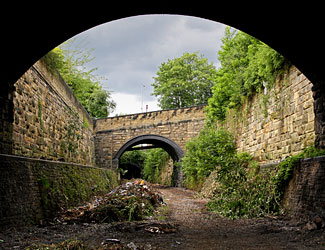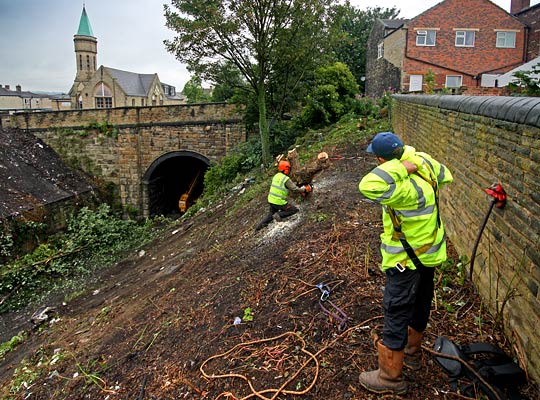The story of Heckmondwike's bridges: Size isn't everything!
The story of Heckmondwike’s bridges: Size isn’t everything!
Think of a striking railway landmark and your mind’s eye would probably picture something iconic: the Barlow train shed at St Pancras, the Forth bridge, Brunel’s crossing of the Tamar, Glenfinnan Viaduct or the like. Few would mentally venture to Heckmondwike, Yorkshire’s third best place name after Wetwang and Slack Bottom. But here too engineers plied their trade, crafting architectural wonders from the purely functional.
The London & North Western’s late arrival in the SpenValley took it on a meandering 13¼-mile route to Farnley Junction on Leeds’ southern outskirts. Although officially titled the Heaton Lodge & Wortley Railway, it was universally known by the more user-friendly title of the ‘Leeds New Line’. More than 1¾ miles of it was below ground in two tunnels; several hundred yards took to the skies on substantial bridges and viaducts. All told, constructing it robbed the LNWR’s investors of more than £1 million. They began to recoup their investment on 1st October 1900.

The line’s southerly approach to Heckmondwike Spen Station took it through a deep cutting before the town’s High Street was conquered, courtesy of cut and cover. To its north, trains entered another cutting as a westerly curve made its presence felt. This one though was spectacular, slicing a deep scar through a residential district. Stitching it together for the benefit of Cemetery Road, Upper George Street, Victoria Street, King Street and Jeremy Lane was a series of imposing bridges – each one unique in character – boasting engineering brick arches and masonry spandrels. Beyond them, another short tunnel carried Bridge Street on the skew.


Though the through route was forced into retirement at the age of 66, regular traffic continued to serve the Charrington Hargreaves oil terminal at Liversedge for another 20 years, crossing from the Lancashire & Yorkshire’s SpenValley line via a new connecting chord. September 1990 saw the official closure notice posted.
That earlier L&Y route – which took a parallel course between Heckmondwike and Cleckheaton – lost its passenger service in 1965 but was still visited by freight trains until 1980. After 20 years of abandonment, eight miles of it was then born into another life as the Spen Valley Greenway – a cycle route and footpath attracting visitors in great numbers. Until recently that is.

As part of a £90 million investment scheme, Yorkshire Water is currently digging it up to lay a sewer main beneath the old trackbed. Work will continue until spring 2010, resulting in sections of the Greenway being closed to the public. This cloud though has a silver lining in the form of a 500-yard diversionary route – paid for by Yorkshire Water – which has been laid along the old LNWR route. This links the Spen Valley Ringway, an isolated section of footpath, with Heckmondwike High Street via the cutting and former station site, now a housing development.
Completion of the work took four weeks, all but a few days of which were taken up by the removal of rubbish, dumped into the cutting over the four years since it was last deep cleaned. That process yielded 35 wagon loads of waste, amounting to more than 300 tonnes – basically, locals have used the place as a landfill.

Tasked with this unenviable clear-up was a team from Sustrans, comprising four men and a subcontracted machine driver. With a 6 metre vertical drop at the bottom, they were forced to use rope access to strip away the vegetation and detritus from the steep-sided banks. A world of squalor confronted them – used needles, wasps nests, rats. Piles of soiled nappies would move in front of their eyes and then disintegrate on contact. Seventy car tyres had to be driven away.
They also faced the perennial construction problem posed by bats – a protected species – which have established hibernation, maternity and transitional roosts through the cutting, particularly in the wing walls.


The main event involved shaping up the ballast with a camber and creating a drainage causeway down the centre of the formation. A 3-metre Terram geotextile membrane was then fitted to prevent weeds and vegetation from establishing themselves. On top of this, a 150mm Type 1 recycled sub-base provided the foundation for a 75mm tarmac layer put down by a Barber Green. Topsoil haunches finished off the job.
So they might lack the scale of Box Tunnel or Ribblehead Viaduct but Heckmondwike’s cutting and the six structures which span it are no poorer for that. They too can enjoy the ‘unique’ tag – it’s not a relative measure. And thanks to the combined muscle of Yorkshire Water and Sustrans, the rest of us can also now enjoy them. A member of the construction team reckons that “it will look amazing in a year’s time”. For those with an engineering eye, it’s looked amazing for a hundred years.


Photos: Noel Feather
More Information
| Lost Railways of West Yorkshire | Pictures of the LNWR route through Heckmondwike |






